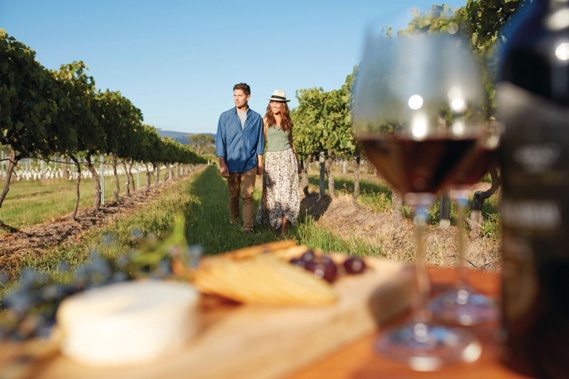
Queensland is synonymous with a bucketload of warmth and sunshine, but for a getaway with a difference, there’s a pocket of countryside southwest of Brisbane that gloriously celebrates all four seasons. After taking in the heritage-tinged sights of Toowoomba, I struck out on the New England Highway for the Granite Belt wine region. Rubbing up against the New South Wales border, the Granite Belt is defined by its distinct seasonality. Rising to an altitude of around 1000 metres above sea level, I awoke to the unexpected frisson of some crispy coats of frost on the lawn, in these parts. It’s a region awash in farm-fresh produce, an award-winning wine trail and a scenic natural playground that’s best explored with boots and a backpack.
Just three hours drive time from Brisbane, I purred through the pastoral folds of the Southern Downs to Ballandean, where Queensland’s first commercially grown grapes were harvested in 1932. Today, Ballandean is home to the Granite Belt’s largest number of award-winning winemakers, renowned for its high-altitude, cool climate wines. It’s actually one of the higher wine regions in the world, almost 900m higher than Bordeaux or Napa Valley. You can swirl, sniff and sip your way through over 50 cellar doors in the region, most of which are small-batch Ma and Pa enterprises.
(Photo / Tourism Queensland)
Don’t miss a visit to the cellar door at Ballandean Estate, Queensland’s oldest family-owned and operated winery. This five-generation winemaking family has been welcoming guests through the cellar door for over 50 years, after first producing wine in 1932. They proudly serve mainstream varieties and recently celebrated 50 years of Shiraz planting and their 30th vintage of Semillon Sauvignon Blanc. Ridgemill Estate is another crowd-pleaser, scooping multiple awards for the distinctive, complex and elegant wines.
(Photo / Tourism Queensland)
I highly recommend a structured wine tasting as part of a winery and vineyard tour with Ridgemill’s winemaker, Pete McGlashan. Pyramids Road Wines should also be on your agenda, where you’ll meet the dynamic husband and wife duo, Warren and Sue. They do it all - from planting and pruning to picking, bottling, and labelling. Their small-batch Merlot, Shiraz and Cabernet Sauvignon will thrill premium red wine drinkers. But beyond mainstream varieties like those reds, luscious chardonnay, Semillon and sauvignon blanc, the biggest thrill about the Granite Belt is the wide embrace of alternative varietal wines – Strange Birds. To be called an alternative a variety must not represent more than 1% of the total bearing vines in Australia.
Enjoyed in Europe for generations these alternative varieties are now emerging as Australian favourites due to their ability to match perfectly with food. Savouring these unfamiliar varieties struck me as an experiential journey of discovery, one glass at a time. Sangiovese, Saperavi, Tempranillo, Durif, Chenin Blanc, Vermentino, Roussane and Sylavner were some of my favourites.
I had a great chat about these Strange Bird varieties while staying the night with Kiwi-born Simon Bull, a winemaker and hospitality pro, who in recent years has been operating the Vineyard Cottages, in Ballandean. Currently being refreshed as Seventh Wines, the collection of cosy cottages are nestled in established formal gardens, with salivating views across the Ballandean Valley to the Roberts Ranges.
The on-site restaurant, fashioned out of an old Presbyterian church, ramps up the character and flavour-factor, as part of a wonderful stay here. Simon has secured a magnificent block of vines behind Ballandean Station (the setting is drool-worthy) and is in the process of developing the site as a glamping destination in the Granite Belt, alongside his new winery, Seventh Heaven. www.vineyardcottages.com.au
One of the legendary names in the Granite Belt wine region is Mike Hayes. The 2017 Australian Winemaker of the Year is an absolute trailblazer in the wine industry, lifting the profile of the Granite Belt, cheerleading sustainable viticulture and always dabbling with alternative varieties. I had the pleasure of meeting him at Balancing Heart Vineyard, a must-see winery. Insatiably passionate about wine production, Mike impressed upon me that he doesn’t perceive himself as a winemaker, but a wine grower.
Mike is adamant that it’s the vines that produce the magic, if tended to with love and meticulous care. He’s future-focused, casting his mind over the viability of winegrowing over the next 50 years. In deference to climate change, pinot noir vines are being removed from Balancing Heart. He’s very proud of Sagrantino, a red grape variety from Umbria that’s been introduced to Balancing Heart – the sole growers of it in Queensland. We had a tasting straight from the barrel – an inky purple wine with an almost-black centre.
The bouquet is one of dark, brooding red fruits with hints of plum, cinnamon and earth. I loved it. We sampled Lagrein, a South Tyrol variety; Carmenere from Bordeaux; and Collarino from Tuscany. I fell under Mike’s poetic spell as he waxed lyrical about a wine that we were tasting “feeling like a butterfly dancing on your tongue.” Balancing Heart Vineyard, which takes its name from the natural rock formation, that looks like a balancing heart, towering above the Shiraz vines, is an unmissable experience.
(Photo / Tourism Queensland)
For an indelible taste of the great outdoors in the Granite Belt, make tracks to Girraween National Park, very close to Balancing Heart. Girraween, meaning ‘place of flowers’, is a park of massive granite outcrops, large angular tors and precariously balanced boulders. If you’re scooting through in spring, spectacular wildflower displays splash colour among the granite. I headed there early in the morning as frogs and lizards and snakes rustled among the leaf litter. (It was too cold for the snakes, apparently.)
I spotted brilliant turquoise parrots and yellow-tufted honeyeaters flitting about the granite-strewn countryside, while red-necked wallabies bobbed about in the woodland. If you’re short on time, take the 30 minute return walk to Granite Arch. Cross Bald Rock Creek and wind through blackbutt and stringybark forest to Girraween's very own natural stone archway. Hello Utah. If you’re feeling as sprightly as a mountain goat, strike out on the two-hour return Pyramid walk, which trails off the Granite Arch track, weaving steadily uphill through eucalypt forests, past rocky outcrops and grassy flats to the base of this massive granite dome.
You’ll need plenty of stamina to make the climb up The Pyramid. The ascent of the exposed rock face is strenuous, but after a lot of huff and puff, the summit views will reward you handsomely. Catch your breath sitting under the wondrous granite boulder of Balancing Rock, while soaking up the majestic views across the forests to the Second Pyramid.
(Photo / Tourism Queensland)
Back on the wine trail, I met up with Cindy from Wine Discovery Tours who hosts beautifully crafted guided tours, stitching together a variety of authentic experiences, from unique handcrafted wines to local produce. It’s a wonderful way to get a flavour for the Granite Belt in one tailormade experience - and not having to worry about the driving! https://winediscoverytours.com.au/
In addition to a fabulous wine tasting at Tobin Wines (I adored their Shiraz), we headed to Jamworks. If you are familiar with Barker’s of Geraldine, this is like the Granite Belt equivalent. This manufacturer of artisan gourmet preserves was founded by Sue and Peter Ingall over 20 years ago and has been under the command of their daughter Stephanie and business partner Christine, since 2015. The local district grows everything you can think of, tomatoes, capsicums, zucchinis,
eggplants, onions, garlic, chilli, stone fruits, many varieties of berries and of course the well-known Stanthorpe Apples.
(Photo / Mike Yardley)
Since taking over, the girls have spent many hours developing café menus to showcase the beautiful flavours of the Jamworks preserves with real food. The café offers breakfast, lunch and sweet treats all with a hint of Jamworks. The product range of jams, relishes, pickles, pastes, sauces and more is extensive, spanning 87 lines of product. The top-seller is the apple strudel jam, which I can confirm is irresistible.
Cindy and I also headed to Varias Restaurant for lunch, which was quite a novelty because it’s located at the Queensland College of Wine Tourism. Varias turned on a superb dining experience featuring an outstanding a la carte luncheon menu. The mallow Organic Lamb was particularly good. With a focus on the best in local produce, prepared and served by hospitality students to a high industry standard, it’s a signature lunch experience, just on the outskirts of Stanthorpe.
(Photo / Mike Yardley)
When a town lays claim to being the ‘coldest place in Queensland’, it’s fitting there’s a Giant Thermometer to celebrate its shivery status. You’ll find the landmark temperature gauge in the heart of Stanthorpe. Later that night, I headed into town to dine at Stanthorpe’s most buzzed about culinary hothouse, Essen. Translating from the German word “to eat”, Essen in Stanthorpe, takes its grow local, eat local approach very seriously.
This quaint and rustic venue with cosy table settings and potted greenery sets the scene to share good honest home-style cooking. You’ll find its menu changes on a weekly basis, to reflect the season and local availability. I feasted on a wood roasted pasture-raised chicken accompanied with pumpkin, winter greens and jus. For dessert, I devoured the delicious Maulwurfkuchen, a German Mole Cake, which consists of unsweetened cocoa powder, heavy cream, bananas and ground almonds. Soo good.
Another divine accommodation experience to add to the check-list is Serenita Stanthorpe, where two next-level glamping tents push the boat out on luxury tenting. Perched on her parent’s undulating cattle property overlooking the tinkling Severn River, Jo Sorbello is your vivacious host, overseeing this seriously indulgent glamping experience. Super exclusive, the two -person glamping tents boast a king-sized electric bed, (I loved the recline features) internal woodfire, outdoor fire pit and barbeque, magnificent stone bath on the deck and private bathroom with rainfall shower.
(Photo / Serenita Stanthorpe)
No expenses have been spared on the design, with each tent also fully appointed with every mod-con you could imagine. The heat pump was a godsend given the thick carpet of frost I awoke to! Revving up the indulgence factor, Jo greeted me with a sublime charcuterie board, brimming with local produce, while a hearty breakfast hamper was eagerly devoured in the morning. It’s an elemental experience in excelsis. www.serenitastanthorpe.com.au
Mike Yardley is our resident traveller on Jack Tame Saturday Mornings
Take your Radio, Podcasts and Music with you









